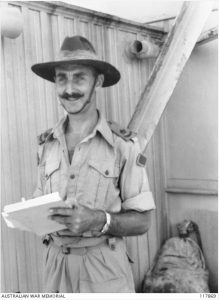Robertson Force, Java Party No. 5A
(with brief history of 2/6th Field Company NSW, Royal Australian Engineers, 7th Division)
ROBERTSON FORCE was 3rd group to depart Java that contained men from the AIF. There were four men from 2/4th in this party.
WX10048 Ted Cosson – arrived back in WA in an appalling state of ill-health. He appeared not to get his life back on track and died quite young.
WX10049 Merve Wilkinson returned to Australia died aged 60 years.
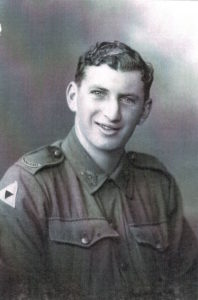
Above: Vidler
WX8585 Cyril Vidler – Vidler returned home a very sick young man. He died in hospital soon after returning Perth on 9 June 1947 Aged 27 years.
WX7230 Les Lee – who was evacuated sick from Burma to Kanchanaburi, Returned to Australia. He died aged 62.
(Lee was with Java Party No. 4 to Singapore. He remained behind because he was ill then joined Java Party 5a, Robertson Force).
The commander of the Australian contingent of 385 men including survivors of HMAS Perth was Major L.J. Robertson of 2/6th Field Company, Royal Australian Army Engineers, attached to 7th Division, 2nd AIF. They departed the Bicycle Camp Batavia for the port of Tanjong Priok on 11th October 1942 bound for Singapore aboard ‘Nichi Maru’.
After arriving in Singapore on 16th October 1942 they remained at Changi for two and a half months. On 7th January 1943 this party departed Singapore by train for Prai on the Malayan mainland opposite Penang. They boarded two transport ships, ‘Nitimei Maru’ (or ‘Nichimei’ Maru) and ‘Moji Maru’ and departed Penang under Japanese Naval escort.
Below: ‘Nitimei’ Maru – Sunk15 January 1943 by US aircraft, transporting 1,500 Japanese troops and 965 Dutch POWs of which 32 POWs died.
You can read further about this ship and loss of dutch lives.
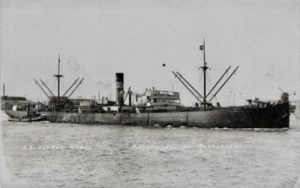
‘On 15 January, a small convoy consisting of Nichimei Maru and Moji Maru (Dutch and Australian POWs aboard) escorted by an auxiliary net layer Chuko Maru and Submarine Chaser No. 8 was steaming to the north toward Moulmein, when they were attacked by US B-24s’ level bombings from high-altitudes. On their first run, three bombs nearly missed to hit Nichimei Maru. On their second run, however, one bomb hit her between No. 2 hold and the engine room, another bomb hit the bridge, and others became near misses. Nichimei Maru came to a stop, rapidly listed to 15 degrees and sank in 30 minutes.
Of the 1,562 Japanese soldiers aboard, 97 were killed along with five gunners and crewmen. A load of rails, hundreds picks and shovels and a locomotive were reported to have been lost. Moji Maru circled the nearby waters for three hours to rescue all the survivors. The surviving POWs arrived at 18 kilo Camp via Moulmein and Thanbuzayat.
Note: On 31 May 1943, remains of the victims were found in the Indian Ocean off Tavoy, Burma.’
On the afternoon of 15 January two B24 Liberator bombers attacked these ships and their escorts. One of the transports, the ‘Nitimei Maru’ took 2 or 3 direct hits, sinking in about 10 minutes. After loitering in the area for about 6 hours, 968 survivors mostly Dutch were rescued and the ‘Moji Maru’ continued her voyage.
Please read a personal story by HMAS Perth sailor, ‘Buzzer’ W.A. Bee about the sinking of ‘Nitimei’ Maru.
They reached Moulmein on 17 October 1943 where they met up with ‘A’ Force.
Between 24th and 28th January, Robertson Force Burma Administration Group 5, as it would now be known as, marched out to its first camp on the railway, Alepauk 18 km Camp.
This was the beginning of a very rough time for this party. Each camp becoming worse than the last. With terrible loss of lives.
Alepauk 18 km Camp, Burma 26 Jan 1943 to 23 Mar 1943
Anderson Force vacated this camp on 3 January 1943 and joined Williams Force at Tanyin 35 km Camp. Work for Robertson’s men began on 26 January mainly with excavation and bridgework.
85 km Camp (Lawa), Burma, 23 March 1943 to 6 April 1943
Robertson Force Advance party left for 84km on 22 March and was followed by the main group. The new camp was located in the mountainous heavily timbered hills in an area of partly cleared jungle. Water was supplied by a small stream that ran past the camp.
80 km Camp, (Apalaine or Aperon) Burma 6 April 1943 to 29 May 1943
Robertson Force suddenly received orders for a move to 80 km Camp. The entire camp aided by two trucks and many ox carts were used to carry baggage and men too sick to walk. This Camp was located about a bamboo hollow but proved to be very hot after 10.00 hours. Work here consisted of bridge work and digging.
The brutality and living (food was minuscle) and working (hours were very long) and horriffic at 80km and 100km resulting in heavy sick rate and many deaths.
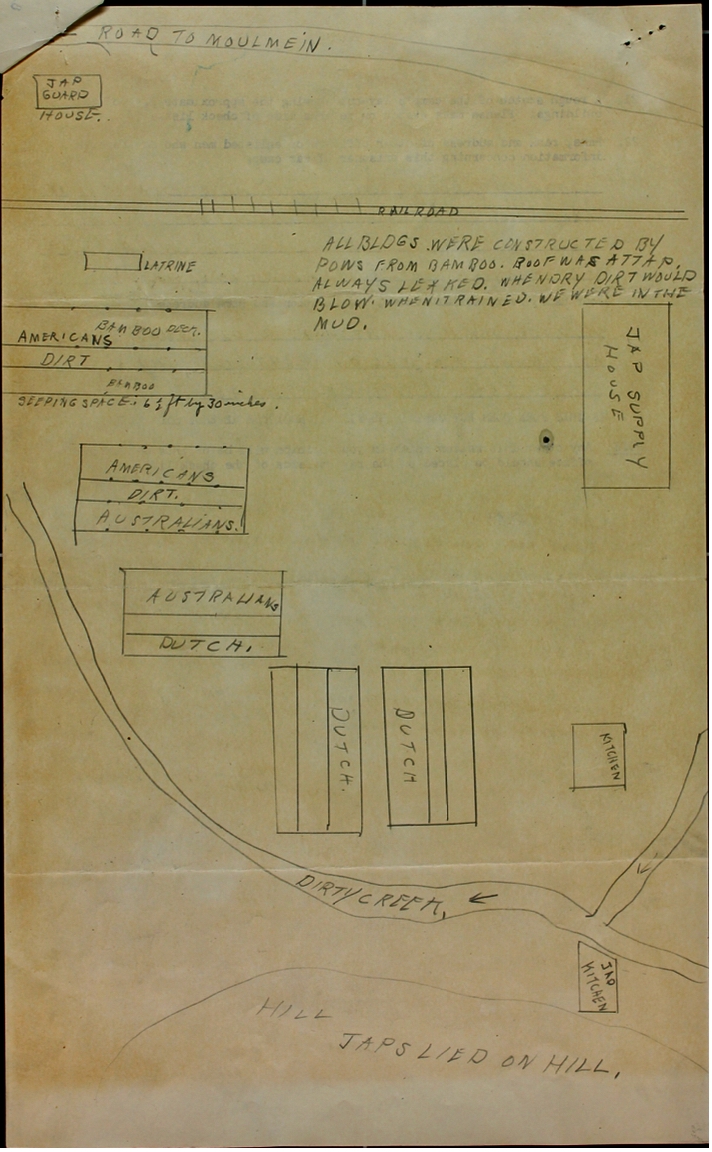 80 km Camp
80 km Camp
Anganan No. 2, 100 Kilo Camp, Burma 29 May 1943 to 26 Jan 1944
Conditions at this Camp can only be described as atrocious. POWs were engaged in arduous manual work with pick and shovels, guarded by Koreans who enjoyed ill-treating the POWs.
In January 1948 Ted Cosson prepared an Affidavit for War Crimes Commission regarding the brutal and sadistic Korean guard known as ‘Snake Eyes’ at 100 km Camp. ‘Snake Eyes’ was a first class private and had charge of the POWs on work parties. Cosson was at this Camp about 8 months until the Camp was disbanded and the POWs marched to Aungganung 105 km Camp on 26 January 1944. The sick were sent to Kanchanaburi.
‘Snake Eyes’ beat the POWs with his fists and thrashed men with his rifle-butt until senseless. The POWs often required hospital treatment after these bashings and some died.
Cosson recorded ‘Snake Eyes’ and another Korean would make POWs stand bareheaded in the sun all day and if the POW moved from his stand to attention position, he would be beaten with rifle butts. ‘Snake Eyes’ and other guards stripped the sick men too ill to work of their ragged clothes to wipe their shoes clean of mud.
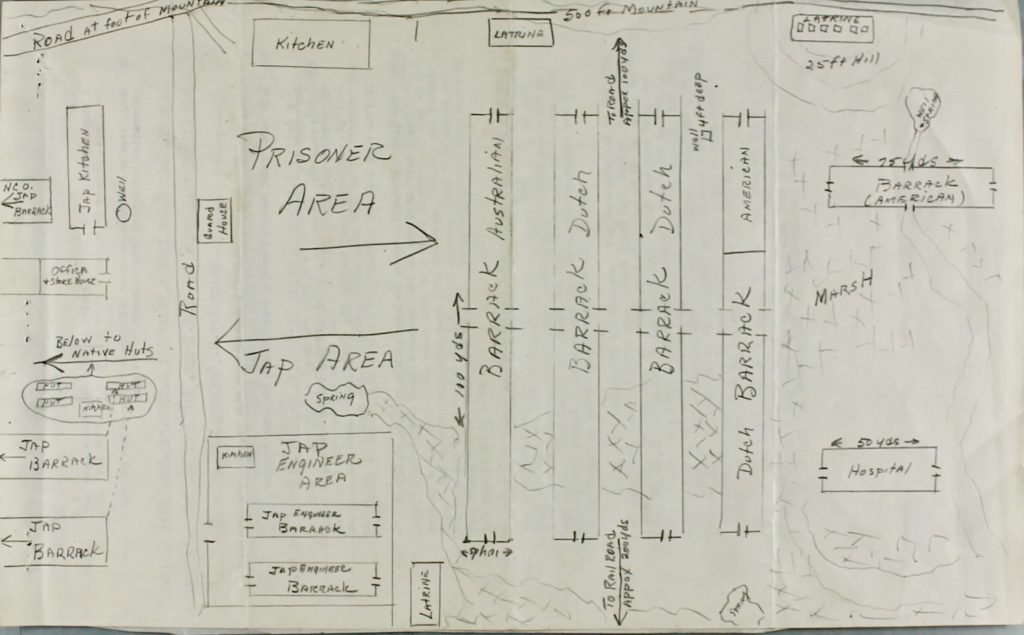
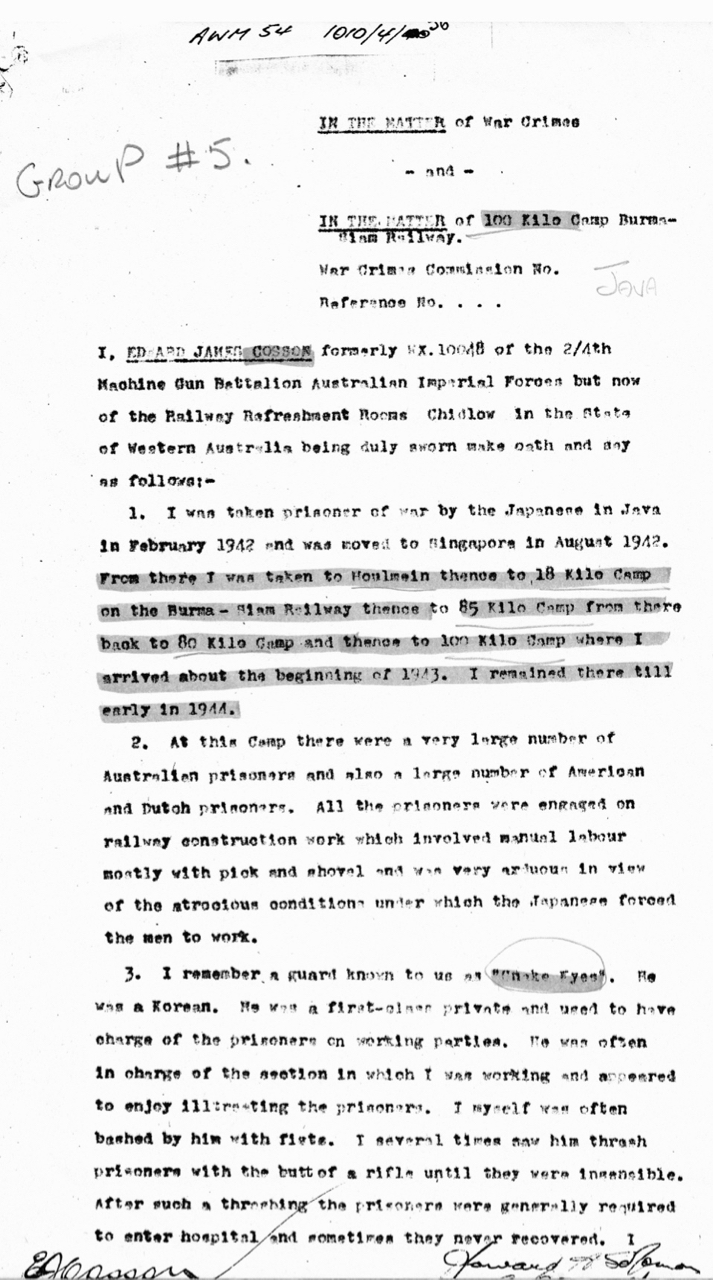
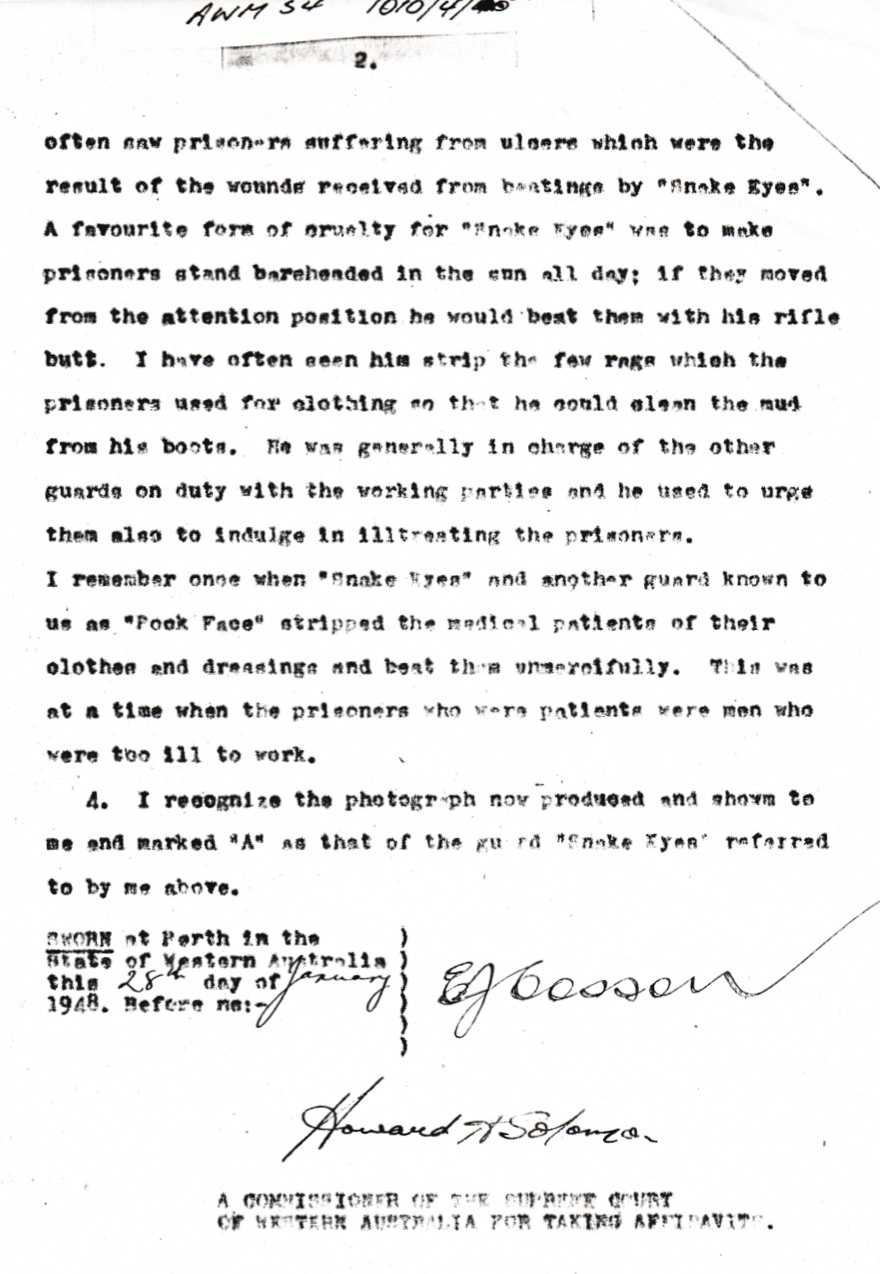
You can read further about 100 km Camp
About 20 POWs from this camp were detached to 83 km Camp but still remained part of the parent group. From 27 Dec to 29 Dec 1943 the first of the sick from Robertson Force Java 5a Party were evacuated south by train to Kanchanaburi, Thailand.
On 26 Jan 1944 the remainder of Robertson Force, 127 Australians and remainder of Americans and Dutch marched into Aungganaung 105 km Camp and were absorbed into Green Force. The remnants of Robertson Force were moved to Kanchanaburi by rail on 24 March 1944 and as of this date Group 5 was completely wound up.
Statistically the Australians fared better than the Dutch and Americans.
The total strength and losses in ‘A’ Force Groups 3 and 5 between 15 September 1942 to 20 July 1944 showed deplorable number of deaths:
Australians lost 15.8%
British lost 27.5%
Americans lost 19.6%
Dutch lost 12.5%
Major Robertson proved to be a leader and his men always came first. Leadership of POWs stood out amongst those who served and worked in Burma, more so than in Thailand.
In December 1943 Major Green was informed the rail link was completed and a small force was to be left behind under the command of Lt-Col Williams. Some of these men remained as part of a railway maintenance party.
There were however several 2/4th men who continued with William’s No. 1 Mobile Force into Thailand. Amongst this group were Padre F.C. Corry, Lt. Kevin Boyle, Graham Wilson, Ken Lee and Private John Malthouse
and From Java Party No. 5a Robertson Force, Ted Cosson and Merve Wilkinson were included.
History of 2/6th Field Company NSW, Royal Australian Engineers, 7th Division
Embarked from Sydney for Middle East on “Queen Mary” to Bombay whey they were transhipped to Dutch liner ‘SS Slamat’ sailing to Egypt.
-
They were transferred with 7th Division to Palestine taking part in the successful Palastine-Lebanon-Syria campaign.
-
The 2/6 Field Company was attached to British army during the defeat of Italian forces in the Sahara Desert prior to arrival of Rommel and German Afrika Korp.
-
The 7th Division was withdrawn to Australia for defence against the Japanese. ‘SS Orcades’ was separated from it’s convoy after debate between the Australian Government and Churchill. Churchill wanted to send 7th Division to Singapore and Curtin refused. -
‘SS Orcades’ with 3,000 Australian troops, mostly support, landed in Batavia, Java, without their weapons which were with the rest of the convoy and continued home to Australia arriving in Adelaide in mid-March 1942. Consequently parts of ‘Black Force’ were poorly armed and short of ammunition.’
-
‘Black Force’ was commanded by Brigadier Arthur S. Blackburn, V.C. – Commanding Officer of 2/3rd Machine Gun Battalion – ‘Black Force’ comprised Dutch, Australian, British & American troops under the overall command of the Dutch Army.
-
When the Dutch surrendered to Japan the remaining Allied Forces, including British, Australian & American troops were also ordered to surrender.
-
The 2/6th Field Company were incarcerated at “Bicycle Camp” – they had lost lost four men KIA and 206 were taken POW.
-
These POWs were later transferred to Changi and shipped to the Burma end of Burma-Thailand Railway.
AT SEA. 1945-10-12. MAJOR L. J. ROBERTSON, OFFICER COMMANDING, 2/6TH FIELD COMPANY, ROYAL AUSTRALIAN ENGINEERS, AN EX-POW OF THE JAPANESE, ABOARD THE BRITISH TROOPSHIP MV HIGHLAND BRIGADE DURING HIS JOURNEY BACK HOME TO AUSTRALIA.
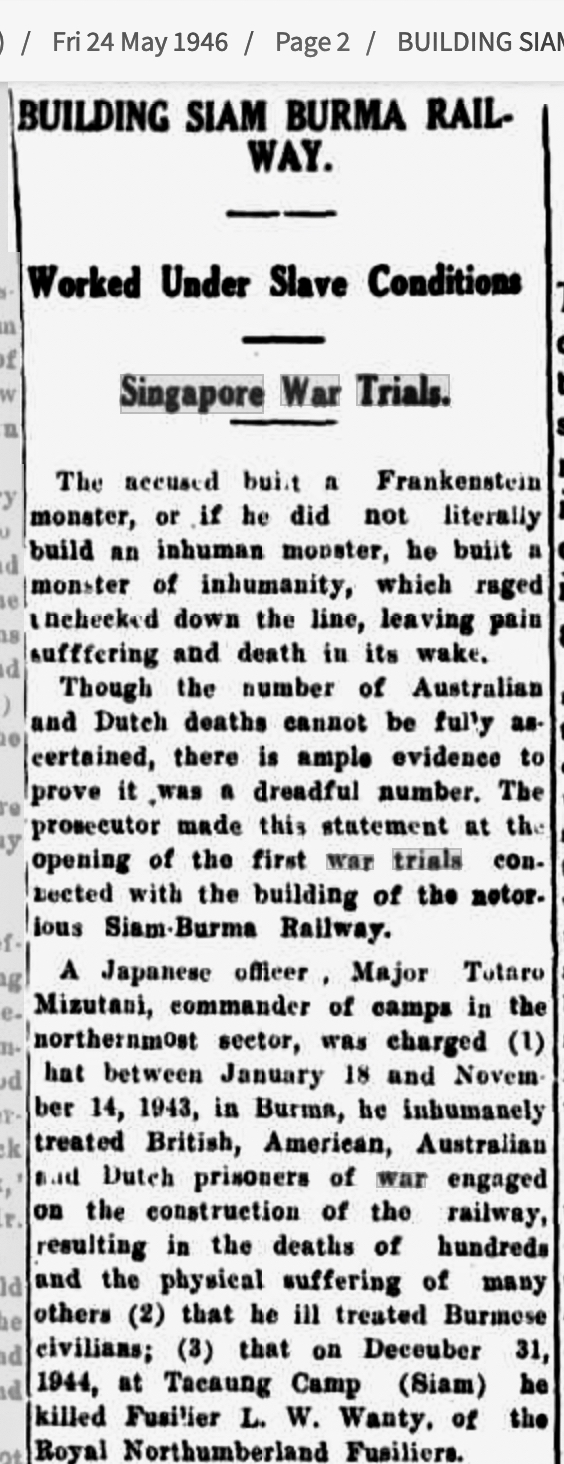
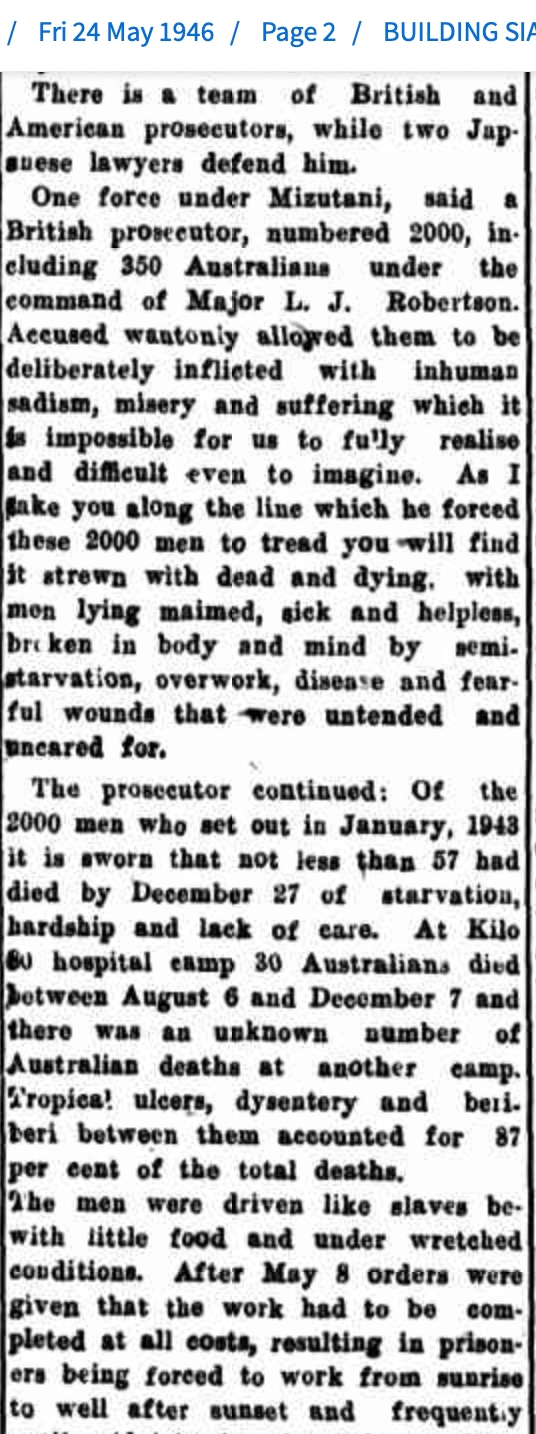
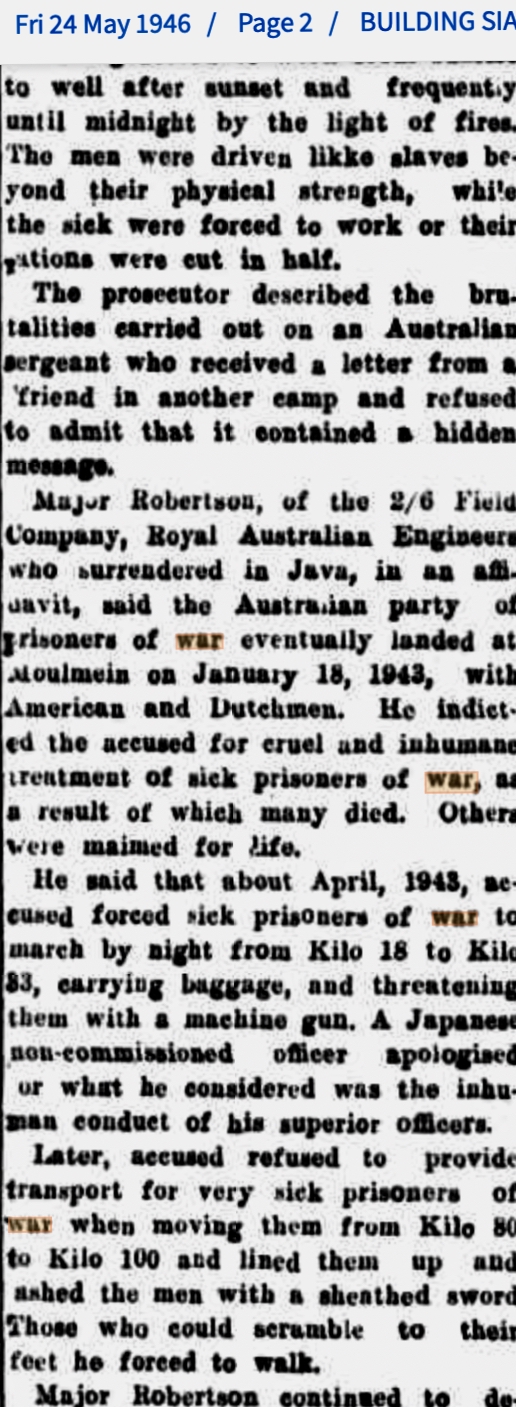
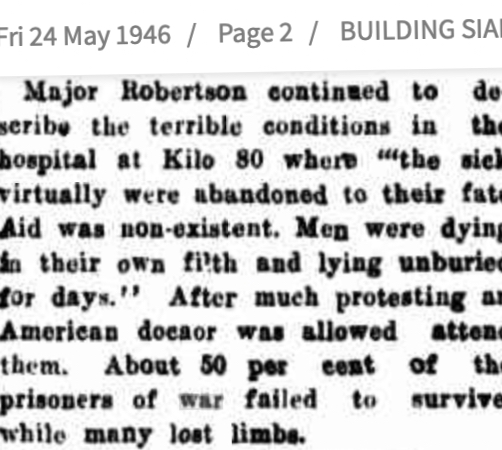
‘The defendant, Major Mizutani Totaro, was accused of three separate charges.
For the first charge, Mizutani was accused of inhumane treatment of P.O.W.s involved in the construction of the Burma-Siam railway. These included, inter alia, forcing sick prisoners to march for over 200 miles to work, failing to provide sufficient food and medical supplies and physical maltreatment. 570 out of around 2000 P.O.W.s allegedly died under Mizutani’s charge.
For the second charge, Mizutani was accused of ill-treating an unnamed Burmese civilian who had been begging for food. Mizutani allegedly took a burning piece of wood and touched the victim with it, causing burns all over his body.
For the third charge, Mizutani was accused of killing a British P.O.W., Fusilier Wanty, L.W., after Wanty was caught wandering outside his sleeping quarters after lights out. Mizutani shot Wanty from the back with a rifle.’ (We thank and acknowledge Singapore War Trials)
Included was the following interesting fact:
‘Mizutani was an elderly former professional soldier who enlisted in 1907 and retired in 1930, but recalled in 1938 at the outbreak of the second Sino-Japanese War. Mizutani’s age (62 at the time of the trial) caused various problems during trial.
The trial also provided an insight into the role of Korean guards in the Japanese Army. Mizutani claimed that Korean guards were volunteers who had signed up under a 2-year contract, but the waning Japanese war effort meant that they were not allowed to return home even after the contractual period. Mizutani stated that he felt that Korean guards were unreliable, and believed that they had no knowledge of firing a rifle. Mizutani also testified that the Japanese HQ did not trust the efficiency and professionalism of Korean guards.’
Major Totaro Mizutani was found guilty and sentenced to hang.

